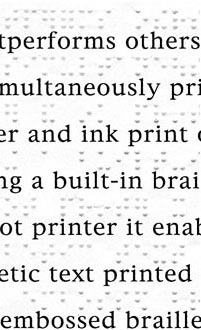with
Standard Interlining
with proposed
DotlessBraille Interlining



|
Actual Gemini Sample with Standard Interlining |
Simulated Sample with proposed DotlessBraille Interlining | ||
|---|---|---|---|
 |  |
 |
|
Telesoft has recently introduced a new embosser that is capable of embossing braille and simultaneously interlining (or overlaying) the embossed braille with inkprint. [Note that it is not necessary to install a Japanese Language Pack to view the English pages at the Telesoft site.] The new embosser, called the Gemini, is available in the United States from Enabling Technologies.
Update--October 2004. ViewPlus has just announced an Ink Attachment for its Tiger embossers which could be used for automated ink interlining of embossed braille.
As Telesoft points out, one use for such interlining is to make a braille textbook "more useful and helpful" for a sighted teacher who doesn't know braille. In other words, the teacher and the braille-reading student can share a single copy of a textbook and both can read it. (See note about the desirability of the print's being above the braille for this purpose.)
Interlining is sometimes contraindicated for braille-using students with residual sight as these students can generally read braille faster when they learn to rely exclusively on their tactile perception. In this case, the Gemini could be used to label an embossed braille copy with inkprint line numbers keyed to a separate simulated braille copy with full interlining. The student would then use the embossed copy while the sighted teacher would use the print copy.
There is a problem with interlining contracted braille if the teacher needs to follow along with the student on a cell-by-cell rather than a line-by-line basis. This is because contracted braille is not one-for-one with print. In other words, it is not usually possible to align standard print directly with the corresponding braille cells. We have developed the DotlessBraille extended font to address this and other situations where sighted persons who don't know braille need to be able to read it.
The picture on the left at the top of this page shows an actual sample of the current Gemini output and the picture on the right shows a simulation of our proposed new interlining. Both pictures show the same braille cells but with different interlining. The Gemini embossed braille on the left is interlined with standard print whereas the simulated braille on the right is interlined with DotlessBraille. (The Gemini sample, which is a apparently a section from a larger page, was obtained from this link. Please select the link for the original Gemini sample plus additional information about Gemini. The DotlessBraille simulation was generated using a standard word processor as explained here.)


The pictures illustrate the difference between line-by-line and cell-by-cell alignment of interlined inkprint. For example, the first word in the samples is transcribed to braille using the single cell contraction for the preceded by the cell for the capitalization indicator. In the Gemini sample, the two braille cells are interlined with the corresponding capitalized three-letter print word which is not exactly aligned with the braille.
In the DotlessBraille sample, by contrast, each braille cell is interlined with a corresponding inkprint character aligned directly with the cell. The indicator is displayed in inkprint as a special symbol similar to the up-arrow on the Shift key of a computer keyboard while the contraction gives the appearance of the three print letters squashed into a single space.

With contracted braille, most braille cells have different meanings in different contexts. For example, the sample shows that the dots-235 cell represents ff in the middle of a word but the word to when joined with the following word. DotlessBraille interlining is based on an extended representation of braille that utilizes unique (multi-byte) character codes for each semantically distinct occurrence of the same braille cell. These unique character codes make it possible for the DotlessBraillle font to reflect the local meaning of each braille cell without the need for back-translation.
We have previously described a transcribing methodology for generating braille as extended braille rather than as ASCII braille; this methodology requires modifications to the tables used as input to transcribing software but doesn't add any computational overhead to the actual transcribing process. In fact, extended braille simplifies the production of interlined braille since the same line of extended braille can be displayed as either embossed braille, simulated braille, or DotlessBraille. However, there are not as yet any commercial transcribing programs that provide output in extended braille.
The Gemini embosser currently prints multi-byte characters when interlining Korean and Chinese braille. Support for interlining English braille with DotlessBraille should not require any changes to the Gemini. However, there is still a need for modifications to transcribing software so as to automate the production of extended braille.
Home |
Site Map |
5-Minute Introduction
Page History: